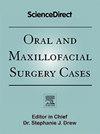手术辅助快速上颌扩张术后颅底骨折合并脑气和脑脊液漏1例报告
Q3 Dentistry
引用次数: 0
摘要
手术辅助快速腭扩张(SARPE)通常是安全的,很少有主要并发症。我们报告一个独特的情况下,22岁的女性脑膜脊膜膨出的历史,谁发展的气脑和脑脊液(CSF)鼻漏SARPE后6天与翼状腋窝分离。影像学显示右侧蝶窦顶部颅底骨折,双侧翼状韧带骨化,可能导致截骨力重定向至颅底。患者表现为体位性头痛,鼻分泌物明显,MRI证实脑脊液渗漏。她成功地通过保守治疗,包括卧床休息,抬高头部和抗生素。本病例强调了认识解剖变异的重要性,这些变异可能使患者在SARPE期间易发生颅底损伤,并强调了及时评估鼻漏和头痛等症状的必要性。早期诊断和非手术治疗可导致良好的结果,即使在存在复杂的颅底骨折。本文章由计算机程序翻译,如有差异,请以英文原文为准。
Cranial base fracture associated with pneumocephalus and cerebrospinal fluid leakage following surgically-assisted rapid maxillary expansion: A case report
Surgically assisted rapid palatal expansion (SARPE) is generally safe, with rare major complications. We report a unique case of a 22-year-old woman with a history of meningomyelocele who developed pneumocephalus and cerebrospinal fluid (CSF) rhinorrhea six days after SARPE with pterygomaxillary disjunction. Imaging revealed a skull base fracture at the roof of the right sphenoid sinus and bilateral ossified pterygospinous ligaments, which may have redirected osteotomy forces to the cranial base. The patient presented with positional headaches and clear nasal discharge, and CSF leakage was confirmed by MRI. She was successfully managed with conservative treatment, including bed rest, head elevation, and antibiotics. This case highlights the importance of recognizing anatomical variations that may predispose patients to skull base injury during SARPE and stresses the need for prompt evaluation of symptoms like rhinorrhea and headache. Early diagnosis and non-surgical management can lead to favorable outcomes, even in the presence of complex skull base fractures.
求助全文
通过发布文献求助,成功后即可免费获取论文全文。
去求助
来源期刊

Oral and Maxillofacial Surgery Cases
Medicine-Otorhinolaryngology
CiteScore
0.60
自引率
0.00%
发文量
43
审稿时长
69 days
期刊介绍:
Oral and Maxillofacial Surgery Cases is a surgical journal dedicated to publishing case reports and case series only which must be original, educational, rare conditions or findings, or clinically interesting to an international audience of surgeons and clinicians. Case series can be prospective or retrospective and examine the outcomes of management or mechanisms in more than one patient. Case reports may include new or modified methodology and treatment, uncommon findings, and mechanisms. All case reports and case series will be peer reviewed for acceptance for publication in the Journal.
 求助内容:
求助内容: 应助结果提醒方式:
应助结果提醒方式:


